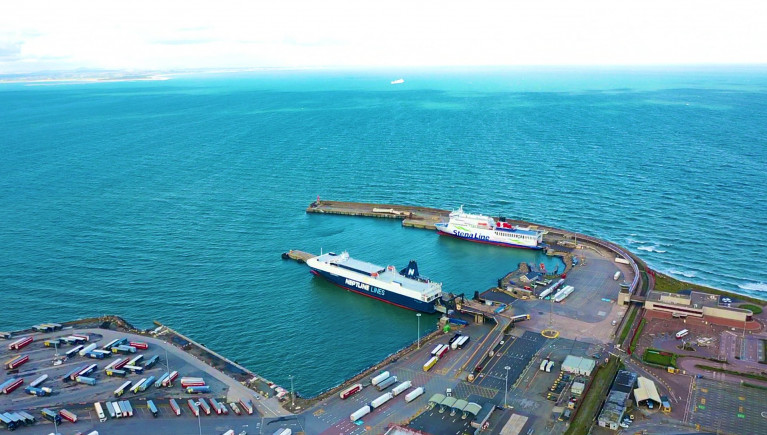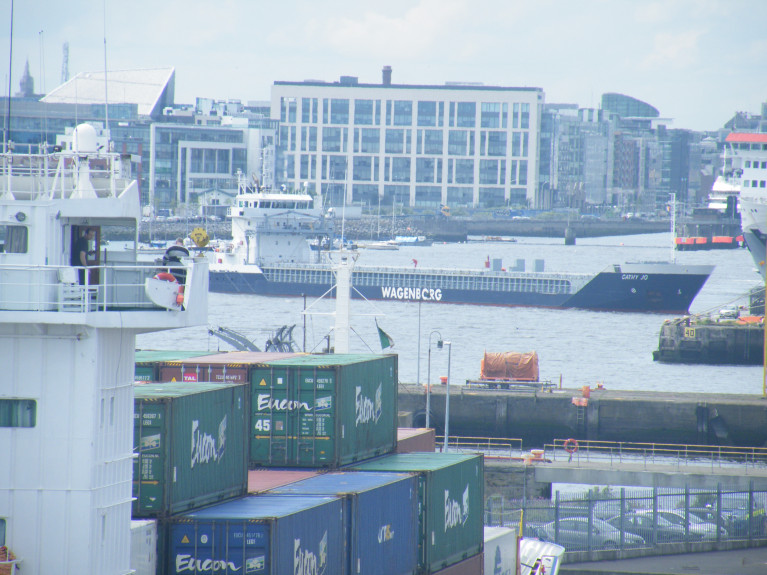Displaying items by tag: IMDO Report
The Irish Maritime Development Office (IMDO) has published its iShips Index of its Quarterly Shipping Report for the period Q2 of 2020 which covers and outlines trends within Ireland’s shipping industry, and as a result, the wider economy.
Below Afloat has highlighted the Quarterly's report focusing on the Ferry sector which of all the maritime transport modes has been most impacted by Covid-19. For more on this including graphs relating to this particular industry can be found (pages 20-24) from the attached download.
The index report accounts for the five separate market segments, representing the main maritime traffic sectors moving through Irish ports. They are Unitised trade which includes Lift-on/Lift-off (LoLo) and Roll-on/Roll-of (RoRo), while Bulk traffic includes Break Bulk, Dry Bulk and Liquid Bulk.
Passenger Market
No Irish maritime market segment has been more severely disrupted by the Covid-19 pandemic and its accompanying restrictions than the market for ferry passengers.
In Q2 2020, just over 1 million fewer passengers passed through ports on the island of Ireland. This represents an 88% decline compared to the same period in 2019. In all, 150,000 passengers either departed or arrived at ports on the island of Ireland in Q2 2020, compared to 1.2 million in Q2 2019.
In Ireland, passenger volumes through Dublin, Cork and Rosslare Europort declined by 91%, equivalent to 644,000 fewer passengers.
In Northern Ireland, passenger volumes declined by 83% through Belfast Harbour and the Port of Larne, equivalent to 415,000 fewer passengers.
Figures 15 & 16 illustrate the passenger volumes recorded across each shipping corridor5 for the first two quarters of 2020 and 2019. The impact of the Covid-19 pandemic on international ferry travel is evident in the totals for Q1 2020, as shown in Figure 15. Passenger volumes through Ireland and Northern Ireland declined by 20% and 16% respectively, compared to Q1 2019.
In Ireland, passenger travel on the Continental route was proportionally the worst affected as the pandemic and its associated restrictions took hold across mainland Europe sooner than that of Ireland and the UK.
However, the disruption caused by the pandemic was felt most in Q2 2020, as presented in Figure 16. As is evident in the table, such disruptions were felt market wide, with no route avoiding precipitous declines in passenger volumes. Proportionally, the Southern and Continental corridors recorded equivalent declines of 93%, or approximately 130,000 passengers each. Volumes on the Central corridor declined by 89%, equivalent to a loss of 380,000 passengers. In terms of market shares, the Central corridor represented a 70% share of the Irish market. This share is 10% greater than in 2019 and was accompanied by declines on the Southern and Continental Corridors, which fell by 5% each.
On the Northern corridor, volumes fared marginally better as passenger numbers declined by 83%, equivalent to 415,000 passengers. The Northern Corridor represented 56% of all passengers on the island in Q2, a 16% increase on the average market share held for the last six years. The lack of requirement for international travel restrictions between mainland UK ports and Northern Irish ports likely contributed to the shallower declines and increased market shares of volumes through Belfast Harbour and The Port of Larne.
Figure 17 provides a graphical representation of the volumes recorded on each corridor. As mentioned above, the precipitous declines in volumes were felt market wide, with the Southern and Continental corridors recording the steepest proportional declines, followed by the Central and Northern corridors.
Figure 18 combines passenger volumes from Q1 and Q2 to illustrate market performance for the first half year (H1) of 2019 and 2020. In H1 2020, roughly 700,000 fewer passengers passed through ports in Ireland, equivalent to a decline of 69% compared to H1 2019. Northern Irish ports recorded roughly 460,000 fewer passengers, a decline of 59% over 2019. The continental corridor recorded the greatest proportional declines of any corridor on the island of Ireland.
In terms of which months were most affected by the pandemic in H1 2020, Figure 19 illustrated passenger volumes from January to June across the Irish ports of Dublin, Rosslare Europort and the Port of Cork. As is evident in Figure 19 below, passenger volumes begin to steadily decline in the first three months of 2020. April and May were the hardest hit months in H1 2020, as pandemic related restrictions on economic activity and international travel, both in Ireland and across Europe, were strictest during this time.
The IMDO has closely monitored passenger travel through Irish ports on a weekly basis since the outbreak of the pandemic in Ireland. Passenger volumes have slowly continued to rise since their lowest point in mid-April, but at the time ofthis publication, remain considerably below volumes recorded in any previous summer period, the peak period for passenger travel. As restrictions on international travel currently remain in place, the ferry passenger market is far from making a full recovery to previous volumes.
Irish Maritime Development Office (IMDO) has today released their Irish Port Traffic Report with figures for Q1 2020
To download the Report click the attachment below the article.
iShips Index
In Q1 2020, the IMDO’s iShip1 index recorded a 6% decline in overall shipping activity. Tonnage declines in the Dry Bulk and RoRo markets drove this decrease, contributing 65% and 30% to the fallrespectively. Across all market segments, the Bulk market makes up 55% of Irish tonnage, the RoRom market 30% and LoLo market 15%.
Unitised Trade
When combined, the RoRo and LoLo sectors make up the unitized trade market. This market largely represents finished goods further along the supply chain than the raw materials traded in the bulk markets. In the three months to March, the total Irish RoRo traffic fell by 5% while LoLo traffic declined by 3%. In order to provide added context and insight to these changes, there were three main contributing factors which should be noted.
Firstly, Q1 2019 experienced significant growth in both sectors. RoRo traffic expanded by 9% while the LoLo traffic grew by 7%, both outpacing its quarterly average of 5% between Q1 2015 – Q4 2018. Driving the growth in Q1 2019 was a period of inventory stockpiling that took place in as the UK’s proposed date of departure from the EU approached on March 29th.
Secondly, a period of inclement weather in February 2020 led to some cancelled sailings, reducing freight carryings during that time. Lastly, restraints on economic activity due to the COVID-19 pandemic began to impact upon the RoRo and LoLo market in the latter half of March 2020. Business closures across retail, construction and hospitality sectors will have begun to impact the both markets from this period onwards. The onset of COVID-19 in March stalled the recovery from lost sailings due to inclement weather in February.
Bulk
As highlighted above, the Dry Bulk market drove almost two thirds of the overall Irish tonnage decline in Q1, reflecting the large volumes traded in this market. A drop in agricultural and construction commodities such as fertilizer, animal feed and bauxite contributed to much of the Dry Bulk decline. Large variability due to seasonal factors and weather patterns are common in these markets.
Covid-19
Also some impact trading was felt in Q1, the restrictions placed on economic activity in Ireland and across the world as a result of the COVID-19 virus will become apparent in Q2 2020 for the Irish shipping markets. It is certain now that there will be considerable tonnage decline across all market sectors. The IMDO continues to monitor these markets closely as well as their indications for the wider Irish economy.































































